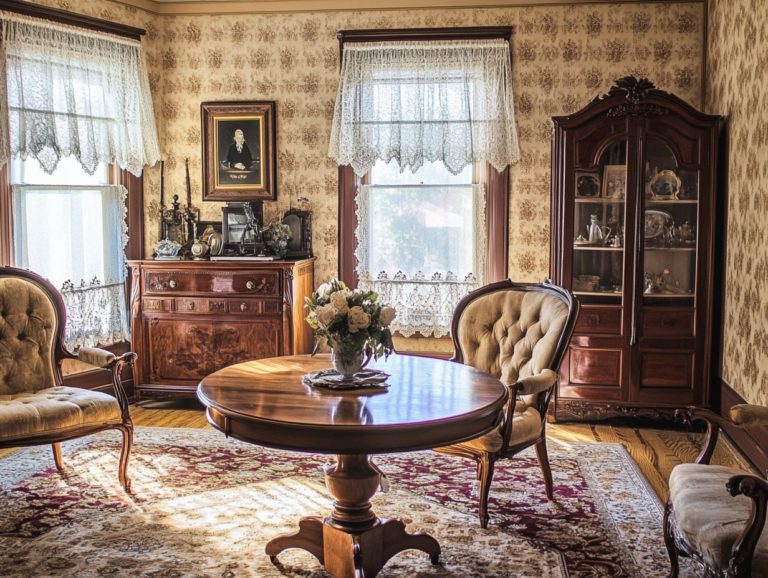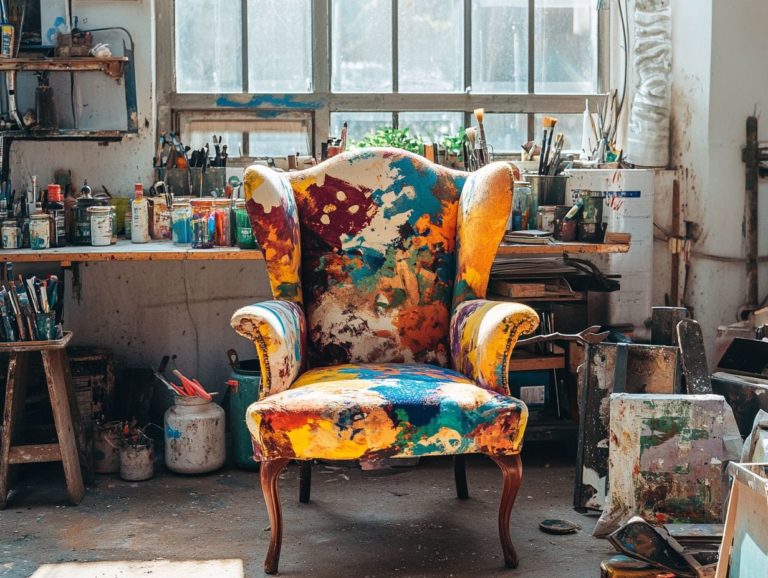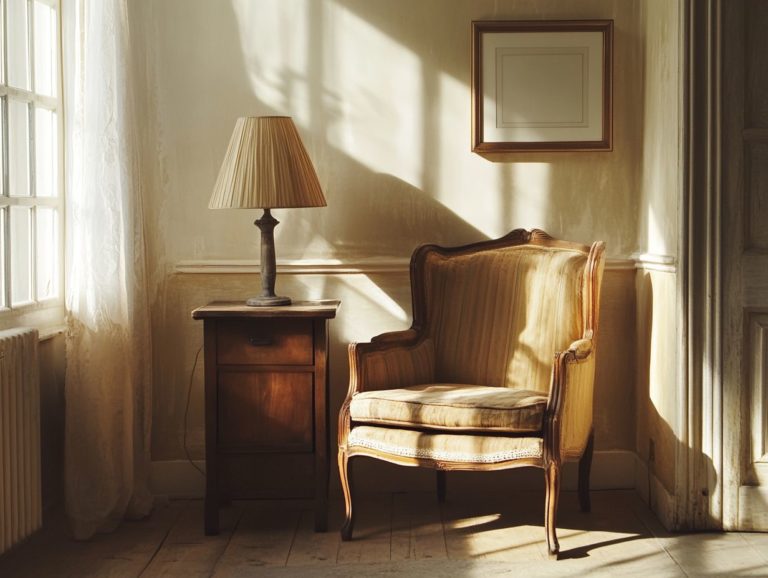5 Vintage Furniture Restoration Projects for Beginners
Do you have a knack for creativity and an appreciation for timeless pieces? If so, vintage furniture restoration might just become your new passion!
This article delves into five beginner-friendly projects, ranging from refinishing a wooden dresser to restoring a mid-century modern side table. Each project provides you with essential tools, step-by-step guidance, and insightful tips to help you sidestep common pitfalls.
Whether you re eager to breathe new life into old furniture or simply wish to master the art of restoration, start your restoration journey today and discover the inspiration waiting for you!
Contents
- Key Takeaways:
- 1. Refinishing a Wooden Dresser
- 2. Reupholstering a Chair
- 3. Restoring a Mid-Century Modern Side Table
- 4. Painting a Vintage Vanity
- 5. Repairing and Restoring a Vintage Sofa
- What Is Vintage Furniture Restoration and Why Is It Popular?
- What Tools and Materials Do You Need for These Projects?
- What Are the Steps Involved in Each Project?
- What Are Some Tips for Choosing the Right Piece of Furniture to Restore?
- How Can Beginners Avoid Common Mistakes in Furniture Restoration?
- What Are Some Additional Resources for Learning More About Vintage Furniture Restoration?
- Frequently Asked Questions
- What are some vintage furniture restoration projects that are suitable for beginners?
- What tools will I need for these vintage furniture restoration projects?
- How can I find affordable vintage furniture to restore?
- What should I consider before starting a vintage furniture restoration project?
- Is it necessary to use special products for restoring vintage furniture?
- What are some tips for successfully completing a vintage furniture restoration project?
Key Takeaways:

- Refinishing a wooden dresser is an easy way to give new life to an old piece of furniture.
- Reupholstering a chair is a great beginner project that can completely transform the look of a room.
- Restoring a mid-century modern side table can be a fun and rewarding project for those interested in vintage furniture.
1. Refinishing a Wooden Dresser
Refinishing a wooden dresser is not just a creative outlet. It s a meaningful way to breathe new life into an old piece of furniture.
By doing so, you align with the principles outlined by the Environmental Protection Agency, reducing furniture waste in the process. Get ready to unleash your creativity with this exciting DIY project! You’ll learn valuable skills in furniture makeovers, with expert insights from professionals like Grace Baena and Whitney Frances Falk enhancing your journey.
When you choose to refinish instead of discard, you play a crucial role in a circular economy. This helps to minimize landfill waste and conserve valuable resources.
Utilizing eco-friendly products, such as Citristrip for paint removal and mineral spirits for cleanup, supports a greener approach. These tools are not only effective but also significantly reduce harmful fumes, ensuring a safer experience for you and the environment.
Industry leaders like ZZ Driggs emphasize the importance of upcycled furniture, highlighting how it contributes to sustainable living. Their expertise underscores that refinishing is not merely about aesthetics; it s a powerful way to positively impact our planet.
2. Reupholstering a Chair
Reupholstering a chair has the power to transform an outdated piece into a stunning centerpiece for your home. It’s the perfect beginner project for anyone interested in reused furniture and sustainable decor.
To embark on this journey, selecting the right fabric is essential. Consider vibrant patterns or soft textures that truly resonate with your personal style. It’s also wise to gather some essential tools like a staple gun, fabric scissors, and a trusty screwdriver.
Sourcing materials can become an exhilarating treasure hunt. Local garage sales or Facebook Marketplace often hide gems just waiting for your creative touch.
Designers like Ashley Harding can inspire your choices, showcasing innovative ideas that elevate even the simplest designs. With a bit of careful planning and a dash of creativity, reupholstering can breathe new life into your space, making it uniquely yours.
3. Restoring a Mid-Century Modern Side Table
Restoring a Mid-Century Modern side table is a rewarding endeavor. It enhances its aesthetic appeal while preserving a piece of design history.
Start by giving the table a thorough cleaning to rid it of grime and old polish. Then, gently sand the surface to prep it for refinishing, ensuring a smooth finish that allows the wood’s natural beauty to shine through.
Updating the hardware can make a dramatic difference in its appearance. Think about sourcing unique knobs or pulls from local flea markets where hidden treasures are just waiting to be discovered.
These markets are a goldmine for quality pieces at reasonable prices, adding unique character to your restored items. Influential professionals like Wendy Smit are shaping restoration trends in Nashville. Her innovative approaches and dedication to craftsmanship inspire others, further elevating the restoration community.
4. Painting a Vintage Vanity
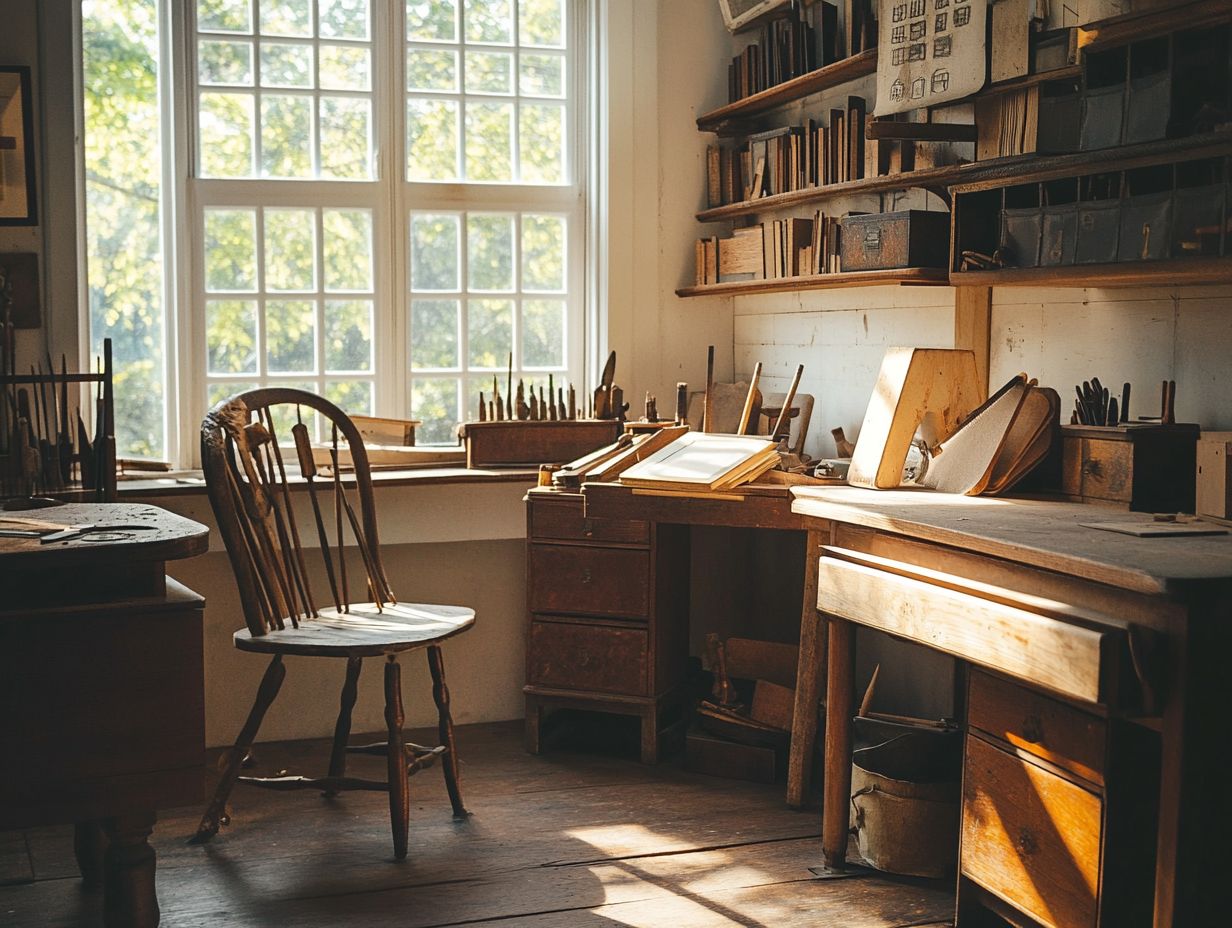
Painting a vintage vanity is an exciting project. It can elevate its charm and functionality.
Take a moment to prepare your vanity properly. Begin by giving it a thorough clean to eliminate any dust or grease; this step is vital for ensuring that the paint adheres beautifully.
Once it s spotless, apply a suitable primer (a base coat to help paint stick) to create a smooth surface, especially if your vanity has a glossy finish. The choice of paint is critical; consider investing in high-quality acrylic or chalk paint, both known for their durability and stunning finish.
Don t overlook the various protective finishes available that can prolong the life of your masterpiece. Platforms like TikTok are full of creative ideas and emerging trends, showcasing unique color pairings and techniques that can inspire your project.
5. Repairing and Restoring a Vintage Sofa
Repairing and restoring a vintage sofa is a rewarding DIY project. It breathes new life into a classic piece and serves as a sustainable alternative to furniture rental.
By examining the condition of the upholstery and frame, you can identify necessary repairs to ensure the sofa s structural integrity. Your choice of materials is pivotal; selecting high-quality fabrics and fillings can enhance the piece s aesthetic appeal and longevity.
Influential figures in the restoration community, like Grace Baena, recommend eco-friendly options, often suggesting reclaimed fabrics to add a unique flair. ZZ Driggs emphasizes various refinishing techniques that improve the sofa s appearance and provide a canvas for personal expression.
This blend of craftsmanship and creativity transforms not just your furniture but your entire space into something special!
What Is Vintage Furniture Restoration and Why Is It Popular?
Vintage furniture restoration is a growing trend that blends creativity with sustainability. By diving into this practice, you not only reduce furniture waste but also embrace unique, personalized decor that speaks to your style.
This approach resonates with the ideals of the Environmental Protection Agency and has surged in popularity, especially on social media platforms like TikTok, where DIY enthusiasts showcase their projects and inspire others to get involved.
There s a special charm in breathing new life into old pieces it gives you a wonderful sense of accomplishment and connects you with a community of like-minded individuals who value craftsmanship and environmental responsibility.
As awareness of environmental issues grows, restoring vintage furniture becomes a practical step in reducing landfill waste. Upcycling vintage chairs can be a fun and creative project. Explore online marketplaces like Etsy and Facebook Marketplace to discover hidden gems, making it easy to connect and share ideas with fellow furniture lovers.
What Tools and Materials Do You Need for These Projects?
To embark on furniture restoration projects effectively, ensure you have the right tools and materials at your disposal. Essentials include paint stripper, protective finishes, and equipment designed for refinishing furniture.
Investing in quality sanders and brushes can significantly elevate your craft. Sanders prepare surfaces smoothly, while a selection of brushes ensures that stains and finishes are applied evenly.
Equipping yourself with appropriate safety gear such as gloves, masks, and goggles is vital to shield against harmful chemicals and dust. Selecting the right materials, like wood stains, sealants, or clamping tools, guarantees durability and enhances the aesthetic appeal of your final piece.
Each of these components plays a pivotal role in achieving a professional, high-quality finish that breathes new life into tired furniture.
Ready to start your vintage furniture restoration journey? Check out this step-by-step guide on restoring vintage furniture and let’s dive in and get creative!
What Are the Steps Involved in Each Project?
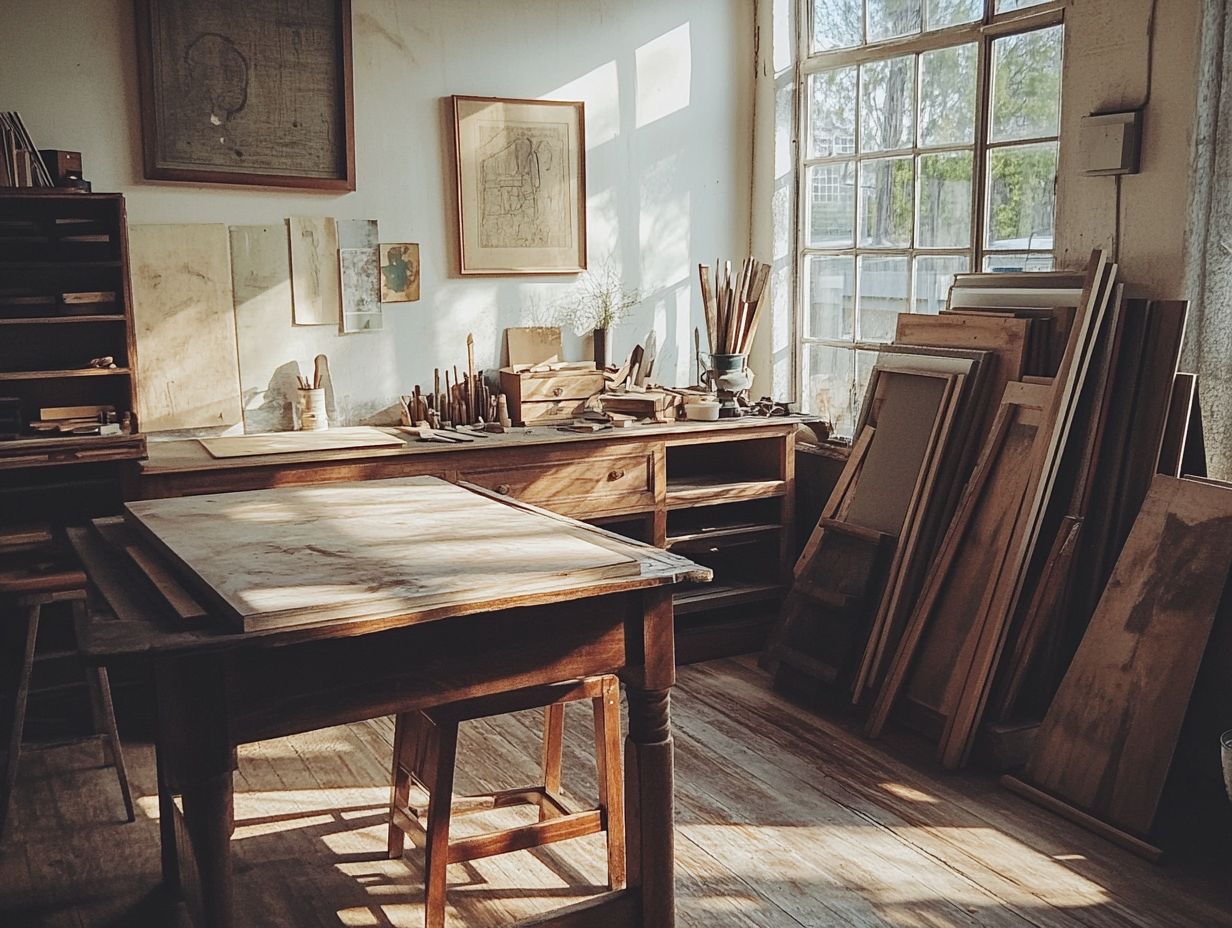
Each furniture restoration project entails essential steps that pave the way for a triumphant outcome. From the initial assessment and planning stages to the meticulous execution and final finishing touches, every phase is crucial.
- Begin with a comprehensive evaluation to pinpoint the materials and tools necessary for your specific task.
- Gather your supplies think sandpaper, paint, or fabric tailored to whether you re refinishing, reupholstering, or painting.
- Create a well-lit workspace. This enables you to see the finer details clearly and work with precision.
Once your area is prepped, immerse yourself in the project. Carefully follow each step with intention. Whether you re stripping old finishes, selecting the ideal upholstery, or picking that perfect paint color, every decision plays a crucial role in the overall success of your restoration journey.
What Are Some Tips for Choosing the Right Piece of Furniture to Restore?
Finding the perfect piece to restore can be thrilling! Your choice greatly influences both the process and the final result.
Be sure to closely assess your potential masterpiece. Examine the joints for strength and check the construction for well-built quality. Keep an eye out for any signs of water damage or pesky infestations. This inspection reveals the item’s restoration potential and helps you determine if the project is feasible.
While hunting for hidden treasures, flea markets and community sales often conceal gems waiting for a makeover. Look for pieces that resonate with your personal style. Engage with sellers; learning about an item’s history can provide valuable insights to inform your restoration approach.
How Can Beginners Avoid Common Mistakes in Furniture Restoration?
As a beginner in furniture restoration, you may face common mistakes that could impede your progress. Recognizing these pitfalls can elevate your learning experience and lead to superior results.
- Overlooking the significance of proper surface preparation, leading to uneven finishes or peeling paint.
- Underestimating the time required for each step, resulting in rushed projects that fall short of your vision.
Dedicate time to research and practice careful techniques to gradually hone your skills. Embrace a mindset of experimentation. Understand that mistakes are an integral part of your learning journey, and each setback offers a valuable lesson for your DIY furniture projects.
What Are Some Additional Resources for Learning More About Vintage Furniture Restoration?
There s a treasure trove of resources at your fingertips if you re eager to deepen your knowledge of vintage furniture restoration. Explore online tutorials on platforms like YouTube and Instagram, or attend community workshops and insightful books.
You might find captivating channels like “Scott’s Reclaim” on YouTube, which expertly guides you through various restoration techniques. Instagram accounts such as “TheRestorationCouple” showcase stunning before-and-after transformations that could ignite creativity for your own projects. Classic literature, like “The Furniture Bible” by Christophe Pourny, offers a thorough overview of restoration methods, materials, and tools. Additionally, you can explore 5 vintage furniture trends making a comeback for inspiration in your decor choices.
Don t overlook the value of joining local community workshops or meetups. These gatherings provide invaluable hands-on experience and connect you with fellow restorers who share your passion. Together, you can foster a supportive network that thrives on exchanging tips and techniques.
Engaging with these resources will undoubtedly enhance the skill set essential for your successful restoration journey.
Frequently Asked Questions
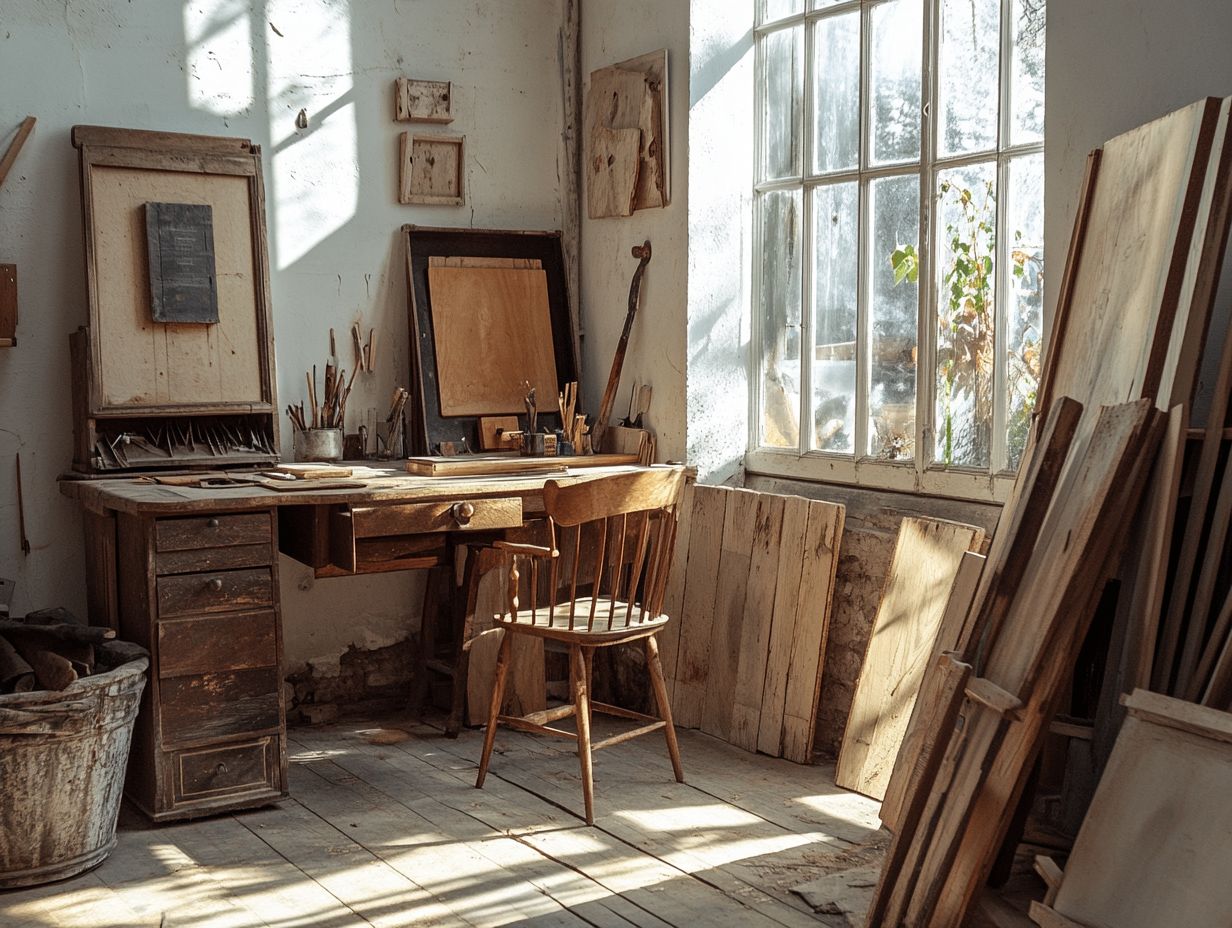
What are some vintage furniture restoration projects that are suitable for beginners?
Ready to dive into vintage furniture restoration? Great projects for beginners include refinishing a wooden dresser, reupholstering a chair, and painting an old table.
You can also restore a vintage trunk or revamp a vintage vanity.
What tools will I need for these vintage furniture restoration projects?
You’ll need basic tools like sandpaper, paintbrushes, a staple gun, a hammer, and wood glue.
Depending on your project, you might need stain, paint, fabric, and other specific tools.
How can I find affordable vintage furniture to restore?
To find affordable vintage furniture, check out thrift stores, yard sales, and online marketplaces.
Ask family and friends if they have any old pieces they don’t need anymore.
What should I consider before starting a vintage furniture restoration project?
Before starting any project, ensure you have enough time and space to complete it.
Consider the condition of the piece and your budget as well. It’s also important to have a clear vision of the end result.
Is it necessary to use special products for restoring vintage furniture?
Not necessarily. You can use traditional products such as sandpaper, wood glue, and paint to restore vintage furniture.
However, there are also special products for specific restoration methods, like furniture wax for refinishing wooden pieces.
What are some tips for successfully completing a vintage furniture restoration project?
Some tips include properly prepping the piece before starting, taking your time, and being patient.
Use quality materials and seek advice or tutorials if you’re unsure about certain steps. Don’t hesitate to reach out for tips every expert started as a beginner!
Remember, mistakes can often add character to the finished piece.

